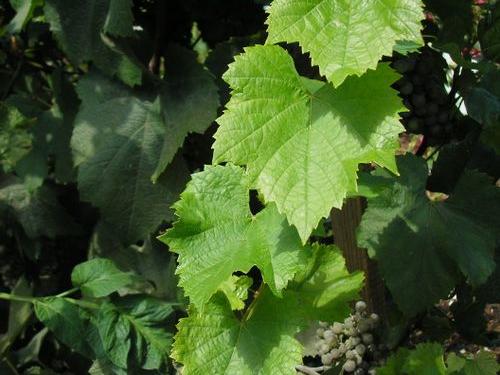
Preserving fresh grape leaves: a tasty endeavor, or “bad news bears”?

The Thompson Seedless grapevine in the Sunset test garden.
The grape season is about to begin, but homemade wine isn’tthe only thing on our minds here in One-Block-Diet land. In keeping with our use-everything-that-is-useablephilosophy, it occurred to us that the leaves of a particular grape vine inSunset’s test garden could make a tasty addition to our next one-block feast, which we’re planning to havein October.
Grape leaves are used extensively in many parts of the worldas tender, mildly-flavored wrappings for everything from spiced, nutty rice togrilled feta. The yummy possibilities were more than enough motivation for usto investigate how to harvest and prepare these leaves for immediate and futureuse.
After doing some research, we discovered that the best timeto harvest fresh grape leaves is late spring to early summer. The later theseason gets, the tougher the leaves become. Whoops.
No matter–our plan is to harvest and preserve thehopefully-still-tender leaves first thing tomorrow. The trouble is, ourresearch has yielded several different ways of freezing and brining grapeleaves, and we’re not entirely sure what method is the best one to implement.
Furthermore, we’re a tad concerned about the potential forbotulism poisoning when canning our leaves. Grape leaves are classified as alow-acid food, and thus if they are improperly canned, they can breed thebacteria that produces the dangerous botulism toxin. Sunset editorial intern Natalie Jabbar, upon hearing news of our canning plans, raises an eyebrow. “I took microbiology a few years ago, learned a lot about dangerous spores,” she says, shaking her head. “Canning is often bad news bears.”
We may be stubbornly curious and slightly crazy, but despiteour misgivings, we’ve put together an action plan, resolving to add plenty ofcitric acid to our brined leaves and to boil the heck out of them after theyare sealed in jars. What followsis a hybrid of several preserving suggestions gleaned from:
Najat Sukhun, who is a longtime home cook and Natalie Jabbar’s mom.(Najat suggested that we use citric acid rather than lemon juice to ensure thatour grape leaf brine has consistently adequate levels of acid to ward offbotulism.)
Fresh Preserving’s official guide to canning low-acidfoods. Exceptionally comprehensive information, with an emphasis on safety.
Ellen’s Kitchen:Where we got a lot of our info. Very clear instructions and appealing recipesat the end.
Mama’s Taverna:Nice pictorial depictions of how to preserve grape leaves.
Kalofagas: One man and his Greek cooking.
If any of you readers are experienced in preserving freshgrape leaves, we welcome any and all advice!
Here are the procedures that we intend to follow.
Picking the GrapeLeaves
Choose leaves that are approximately the size of a woman’shand, and which are light to light-medium green. Najat advises looking for shiny, smooth leaves and steeringclear of fuzzy, thick ones. Also, make sure your leaves come from vines thathave not been sprayed with pesticides.
To Use Immediately
- Rinseyour leaves well and pat dry.
- Bring1 part salt to 4 parts water to a boil. Blanch leaves in batches of 12-15, covering them withthe boiling water and blanching for 2-3 minutes. Remove leaves and place them in ice water until fullycooled. Dry with atowel.
To Freeze
- Followthe above steps, then stack similar-sized leaves 6-20 at a time, lay them flat so they don’t crack, and place them in freezer bags. Freeze for up to 6months.
- Touse, thaw in a colander and use immediately.
To Brine
- Sterilizeseveral canning jars by putting them in a pot of water and boiling for 10minutes. Lower the heat to a simmer and keep jars in the hot water untilneeded.
- Placelids (without bands) in another saucepan and place over medium-low heatuntil bubbles form (do not boil). Remove from heat and keep lids in thehot water until needed.
- Fillyour canner/boiling pot halfway with hot water and bring to a boil overmedium heat.
- Removejars from the pot of hot water using a jar lifter.
- Tieblanched leaves into bundles.Gently push bundles into jars with a wooden spoon, leaving a good1½ to 2 inches between the bundle top and the jar’s rim.
- Preparethe brine by boiling ¼ cup kosher salt with every 4 cups of water youuse. Add 2 ½ to 3 tsp citricacid powder for every 4 cups of the brine. Boil brine (with citric acid)for a minimum of five minutes, then pour the hot brine into yourleaf-filled jars. Make surethat the brine covers the leaf bundle by at least 1 inch.
- Removeair bubbles by running a clean knife inside the rim of each jar.
- Removejar lids from their hot water using tongs. Place lids on top of jars sothat sealing compound on lids meets the jar rims. Seal the jars by placingbands on jars and tightening them firmly (do not force). Place sealed jarsin canner/boiling pot and fill with enough water to cover jars by about aninch. Boil, covered, on high heat for 15 minutes. Let jars cool and storein a dark, cool place for up to a year.
For more tips onSunset’s way to can, click here.
We’ll keep you posted on how this all turns out!
By Kaitlin Louie, Sunset food intern

